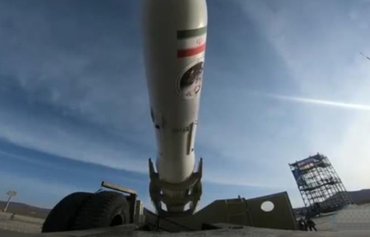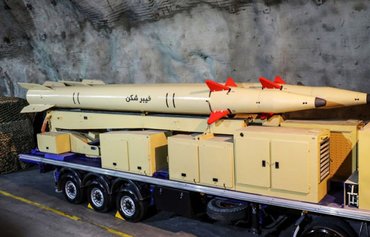Iran failed in an attempt to launch a satellite into space in early June, according to the US military and satellite images of the Iranian space centre in Semnan.
The incident, confirmed by the Pentagon, is the latest in a string of embarrassing failures that have beset Iran's space programme.
"US Space Command is aware of the Iranian rocket launch failure which occurred early June 12," said Pentagon spokesman Uriah Orland.
The Iranian regime gave no explanation why the launch attempt at Imam Khomeini Spaceport failed. It rejected AP and CNN reports that broke the news on Wednesday (June 23), saying its satellites remain on the ground.
![Arrows drawn on a satellite image taken June 6 by Maxar Technologies show heightened vehicle activity at Imam Khomenei Spaceport in Semnan province, Iran. [MIIS]](/cnmi_am/images/2021/06/24/30459-iran-satellite-launch-600_384.jpg)
Arrows drawn on a satellite image taken June 6 by Maxar Technologies show heightened vehicle activity at Imam Khomenei Spaceport in Semnan province, Iran. [MIIS]
There are signs that Iran will attempt another launch soon, CNN reported, quoting analysts at the Middlebury Institute of International Studies (MIIS).
In a thread on Twitter, MIIS professor Jeffrey Lewis said he and colleague Dave Schmerler, senior research associate at the MIIS James Martin Centre for Nonproliferation Studies, had studied a June 6 image of the spaceport.
The Maxar Technologies image showed indicators that normally accompany space launches in Iran, he said, noting that "these are the same signatures that we used to predict previous space launches".
The images showed more than a dozen vehicles at the spaceport's horizontal checkout building, he said, which is "something that only happens before space launches".
"Another signature was specialised equipment at the mobile launch gantry including two specific vehicles and a mobile work platform," he said. "We never see this equipment except before space launches."
Earlier images taken June 1 from the Planet fleet of earth observation satellites revealed "fuel containers, as well as a possible oxidiser container", he said.
"Again, there is only one reason to bring so much fuel to the site."
Workers have used the gantry -- a movable framework for supporting and servicing a rocket prior to launching -- this year to launch Simorgh (Phoenix) satellite rockets on several occasions, he pointed out.
Later images revealed decreased activity at the site, he said, adding, "We were pretty sure the launch failed."
The Pentagon later confirmed the launch failure to CNN.
It is likely Iran will try again, Lewis said, as new imaging from Planet on June 20 showed renewed activity at the site, where fuel tanks and support vehicles appear to be massing for another launch.
A source of embarrassment
Iran's last space launch took place in April 2020, placing a microsatellite, Nour-1, in orbit, said Orland.
But the military satellite appeared to have problems, US officials said from the beginning.
"Our persistent observations of this object demonstrate it is uncontrolled and not operational," Orland said.
Nour-1 has been a source of embarrassment for Iran, as the Islamic Revolutionary Guard Corps (IRGC) claimed it used images captured by the satellite to help it co-ordinate a military exercise last July.
The satellite took images of other areas in the region, including al-Udeid air base in Qatar, the IRGC claimed as well.
But shortly afterwards, observers noticed great similarity between the released images and those taken by Google Earth, sparking speculation that the Nour-1 images were not authentic.
Last July 29, BBC Persian published a report fact-checking the authenticity of the images.
The report compared images side by side and pointed to their quality and details, which were clearly similar to those in Google Earth's 2016 pictures of the al-Udeid base. The Google Earth photos are available for free on the app.
In an earlier attempt, Iran in February 2020 said it "successfully" launched the Zafar ("Victory") satellite but failed to put it in orbit.
Iran's denials
On Wednesday, the Iranian Students News Agency quoted Mohammad-Javad Azari-Jahromi, Iran's minister of information and communications technology, denying the failure of a satellite launch.
Azari-Jahromi said Iran's space programme continues to be active "based on the supreme leader [Ali Khamenei]'s guidance and the president [Hassan Rouhani]'s remarks. The programme has focused on three pillars."
He did not elaborate on the "three pillars".
Iran has a long history of denying mishaps and failures.
The most recent notable example of this was in January 2020 when the IRGC shot down Ukraine International Airlines Flight 752 bound for Kyiv, a failure that cost the lives of everyone -- 176 civilians -- onboard.
Despite video and circumstantial evidence pointing to a surface-to-air missile hitting the airliner, Tehran continued for days to deny a missile strike took down Flight 752.
Iranian President Hassan Rouhani finally admitted the truth -- that the IRGC shot down the plane.
That admission -- and the appearance of an attempted cover-up -- sparked days of anti-government protests in Iran.

![This photo shows an Iranian satellite before launch in April 2020. [IRGC]](/cnmi_am/images/2021/06/24/30462-iransatellite-600_384.jpg)






